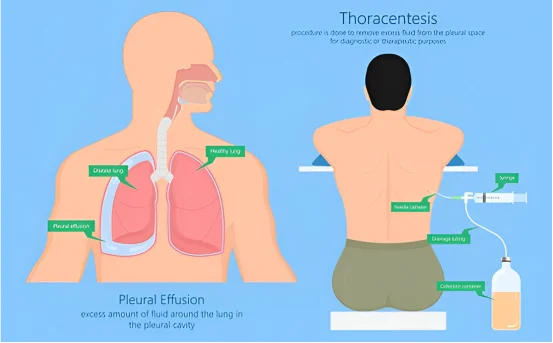The Wedge Resection Surgery is a minimally-invasive procedure that removes a wedge-shaped section of the lung or another organ that contains abnormal tissues such as a tumour, infection or scar. This procedure is usually performed when a lesion is localized, and doesn’t require the removal of a whole organ or lobe. It is important to understand the treatment for wedge resection surgery as it plays a crucial role in patient recovery.
The most common use of wedge resection in diagnosis and treatment is for early-stage lung carcinoma, benign nodules or metastatic tumors. Wedge resection is less invasive than other surgeries and preserves lung function. It also has a shorter recovery time. This is the preferred method when the goal of the surgery is to remove an abnormal mass and preserve as much healthy tissue possible.
This method is part of the broader discussion on the treatment for wedge resection surgery, emphasizing its effectiveness in preserving lung function.
Why Is Wedge Resection Surgery Performed
The wedge resection is recommended for a variety of medical reasons:
- Diagnosis Lung Nodules :- Patients who have abnormal findings in a chest X ray or CT scan, such as small lung nodules, may undergo wedge resections to determine if the growth is benign or cancerous.
- Early-Stage Lung Cancer Treatment :- If lung cancer is diagnosed at an early stage (especially Stage I Non-Small Cell Lung Cancer, NSCLC), wedge resection can be used to remove tumors before they spread.
- Metastatic Lung Tumors :- The wedge resection is a good option if cancer has spread from one part of the body to the lungs.
- Benign Lung Conditions :- A wedge resection may be indicated in conditions such as arteriovenous malformations or localized infection.
- Poor lung function or high-risk patients :- Patients who do not qualify for major lung surgery because of age or other health issues can opt for wedge resection as an alternative to lobectomy and pneumonectomy.
How is the wedge resection procedure performed?
Understanding the Treatment for Wedge Resection Surgery
Two primary methods can be used to resect the wedge:
- Video-Assisted Thoracoscopic surgery (VATS) :- This minimally-invasive technique utilizes a camera for guidance and small incisions. This is the preferred technique due to its reduced pain, quicker recovery and minimal scarring.
- Thoracotomy (Open Surgery) :- Open surgery may be required in some cases. This is especially true when it’s difficult to reach the tumor. Although more invasive, this method provides better visibility and control.
The Procedure in Step-by-Step Detail:
- The patient is put under general anesthesia.
- The chest wall is incised with small incisions.
- The lungs are visualized using a thoracoscope.
- The surgical tools are used to remove the wedge of lung tissue.
- The tissue is sent to be tested or for biopsy.
- The incisions are closed and chest tubes can be inserted to drain fluids.
The procedure can last between one and three hours depending on the location, complexity, and size of the tumor.
Postoperative care and recovery
The recovery after wedge resection depends on a number of factors, including the overall health of the patient, the surgical technique, and any complications.
Recovery Time Line:
- Hospital stay: 2-5 days (may be less for VATS patients).
- Full recovery: 2 to 4 week for minimally invasive surgeries; 6-8 weeks or open surgery
After-Surgery Tips:
- Pain Management: Pain medication and breathing exercises reduce discomfort.
- Chest Tube Management: Tubes can be removed after lung function has stabilized.
- Exercise: Walking and breathing exercises can help prevent pneumonia and improve lung function.
- Follow-Up Visits – Regular follow-up visits are required to monitor healing results and pathology.
During the first few weeks of recovery, patients should refrain from heavy lifting, smoking and strenuous activities.
Risks and complications
As with any surgical procedure there are risks associated with wedge resection. It is considered to be safe when performed by a thoracic surgeon with experience.
Some of the most common risks include:
- Bleeding
- Infection
- Lung air leakage
- Pneumonia
- Reaction to anesthesia
- Postoperative fatigue or pain
Long-Term Outlook:
The majority of patients are able to return to normal activity within a couple weeks. Based on the results of the biopsy, additional treatment such as radiation or chemotherapy may be recommended.
The Benefits of Wedge Resection Surgical Procedure
- Only the affected part of the lung is removed, preserving lung function.
- Options that are minimally invasive
- Diagnostic and therapeutic – can confirm or treat diseases
- Major lung surgery requires longer hospital stays, but recovery is faster.
- Ideal for elderly or high-risk patients who can’t undergo extensive surgery
Conclusion
The wedge resection procedure is a minimally invasive, yet valuable, surgery that can be used to diagnose and treat localized lung diseases, such as early-stage lung tumors and cancer. The thoracoscopic technique has improved the safety, effectiveness, and efficiency of this surgery. Patients can expect a quicker recovery with fewer complications.
Consult a board certified thoracic surgery to better understand the risks and outcomes of a wedge resection. Early intervention and individualized care can make a big difference in the prognosis.























